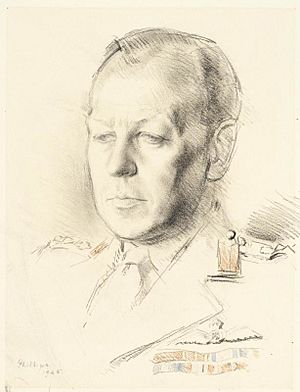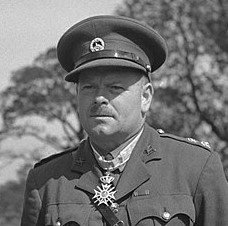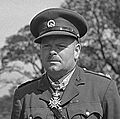Advanced Headquarters 'A' Force facts for kids
Advanced Headquarters 'A' Force, usually called 'A' Force, was a secret group during the Second World War. It was set up in March 1941 in Cairo, Egypt. Brigadier Dudley Clarke led this special team. General Archibald Wavell, who was in charge of forces in North Africa, started using deception in December 1940 during Operation Compass. After that operation worked well, Wavell asked Clarke to create the first official deception department. Clarke had worked with Wavell before in Palestine. He started this new group secretly and with very few resources.
Contents
Why Deception Was Needed
On June 10, 1940, Italy declared war on the Allied nations. The British forces in the Middle East, based in Egypt, were led by General Archibald Wavell. They fought defensively against Italian troops at first. Then, in the autumn, they began to plan attacks.
In November, Wavell planned an attack called Operation Compass. This was against Italian soldiers at Sidi Barrani. As part of this plan, he tried to trick the enemy. He wanted them to think British forces were weaker or in a different place. They used false information and visual tricks. Operation Compass happened on December 9 and was a big success. Wavell thought the deception helped a lot. On December 13, he told his commanders he wanted to create a special team for deception. He asked for Dudley Clarke to come to Cairo to help.
Clarke arrived in Egypt on December 18. At first, he worked alone and in secret. His official job was "Intelligence Officer (special duties) to the Commander in Chief." He had no staff or official orders. He worked from a "converted bathroom" at the British Army headquarters in Cairo. His secret cover job was to set up a local office for MI9. MI9 was a less secret group that helped Allied soldiers escape if they were captured. Clarke actually ran MI9's Middle East office while also doing his deception work until August 1944.
'A' Force Is Born
By 1941, Clarke started working with other people. These were experts in different kinds of deception. Major Victor Jones was an engineer. He had already used dummy tanks to trick the enemy in battles. Mark Ogilvie-Grant was a Captain in the Scots Guards. Clarke hired him to help spread false information.
In January 1941, Clarke started making up stories about a British paratrooper (airborne soldier) group in the area. This was called Operation Abeam. He got the idea from an Italian officer's diary found in December. The diary showed the officer was afraid of an attack from the air. It would be two years before Allied paratroopers actually went to North Africa. But Clarke wanted to make these fears stronger. He created a fake "Special Air Service Brigade." Major Jones built many fake gliders. Clarke also set up fake radio messages and let false information "leak" out. He even dressed two soldiers in "1 SAS" uniforms. He sent them to walk around Cairo, Port Said, and Alexandria. They would hint about secret missions in Crete or Libya.
By March, Clarke had another big plan. This was to hide the real plan for Operation Cordite. Operation Cordite was when the 6th Infantry Division would invade Rhodes, a Greek island. Clarke was interviewing local people about Rhodes. He didn't want this work to be linked to the 6th Division. So, he started using the name 'A' Force. The name was meant to be vague. It helped add to the mystery of his made-up airborne unit. At first, it was just a cover name. But soon, 'A' Force became a real department. It took control of all deception work in the region. "Advanced Headquarters 'A' Force" moved into new offices on 8 April 1941. Clarke then began to hire his staff.
Challenges for 'A' Force
Once 'A' Force was set up, Clarke felt he could leave Cairo. He wanted to find new contacts outside of Egypt. He traveled to Turkey. His goals were to set up an MI9 office there and find ways for 'A' Force to send false information to the enemy. While Clarke was away, Victor Jones was in charge of 'A' Force.
When Clarke was gone, a struggle for power began. This happened at the Middle East Command. In October, a new and rising officer, Colonel Ralph Alger Bagnold, was made "Chief Deception Officer" for the region. Bagnold and his team took over tactical deception (tricks used in battles). This left 'A' Force to handle bigger, strategic plans. When Clarke returned to Cairo, he was upset. He felt Bagnold had taken his power. He was also annoyed by the public attention around Bagnold's new job. Clarke had worked hard to keep deception a secret. Over the next few months, Bagnold's group started to control most of the deception planning. 'A' Force was left to train people and give advice. However, Victor Jones still controlled much of the physical deception work.
What 'A' Force Achieved
'A' Force was a very important step for the Allies' deception efforts. Clarke's report in September 1941 directly led to the creation of other deception groups. These included the London Controlling Section and Ops. (B). 'A' Force helped focus on using deception in warfare until the end of the war.
Who Was in 'A' Force
'A' Force was officially part of the Middle Eastern Command in Cairo. Besides planning deception in North Africa, it also acted as the MI9 office for the region. This cover job meant many staff members worked on escape and evasion. The group grew quickly. By the end of the war, it had many people. Here are some of the key individuals:
| Dudley Clarke | He started 'A' Force and led it until the war ended. | |
| Noel Wild | He joined in 1942 to lead the Operations section. He was also Clarke's second-in-command. Wild was known for being very determined. He moved to England in 1943 to lead his own deception group (Ops (B) under SHAEF). He helped plan Operation Bodyguard. | |
| Victor Jones | He was hired for his knowledge of visual deception, especially fake tanks. Jones managed the physical tricks for Clarke. He was even the temporary head of 'A' Force for a short time in late 1941. | |
| Jasper Maskelyn | He was a famous stage magician. Clarke made it seem like Maskelyne was the genius behind many of 'A' Force's fake machines and visual tricks. This made the inventions seem more believable to commanders. It also helped hide the real secret activities of the department. Maskelyne actually worked on escape devices and gave talks for the MI9 part of 'A' Force. | |
| E. Titterington | He was a forger. He made all the fake passports and other documents for the department. He also had the job of secretly opening diplomatic bags from neutral countries. This allowed Clarke to read their contents before sealing them back up. | |
| Mark Ogilvie-Grant | He helped with the information warfare and the MI9 cover work. |
Images for kids







